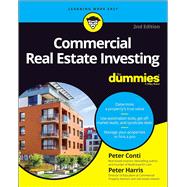If you're looking for more detailed advice on the commercial real estate market than, "Buy low, sell high," you've come to the right place. Commercial Real Estate Investing For Dummies is where you can find the smart, straightforward, and accurate info you need to get your start—or grow your portfolio—in commercial real estate.
You'll learn foundational strategies, tips, and tricks for investing in all sorts of commercial properties, from apartments to shopping malls. You'll also get rock-solid advice on:
- How to get started in commercial real estate investing, even if you've never tried it before
- How to work with business and investment partners and protect your own interests with contracts
- Financing your investments with a variety of instruments and taking advantage of legal tax opportunities
Growing wealth by investing in real estate is a strategy as old as money itself. Do yourself a favor and get in on the action with this straightforward and up-to-date guide!








